Attached files
| file | filename |
|---|---|
| 8-K - FORM 8-K - DITECH HOLDING Corp | c25351e8vk.htm |
Exhibit 99.1
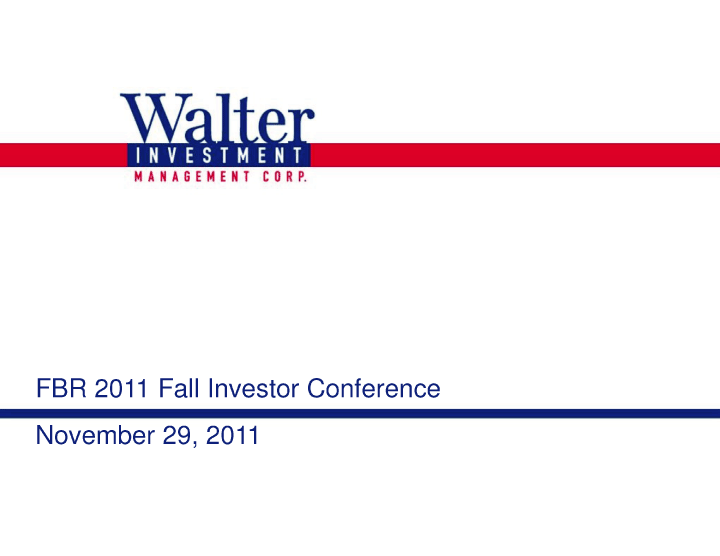
| FBR 2011 Fall Investor Conference November 29, 2011 |
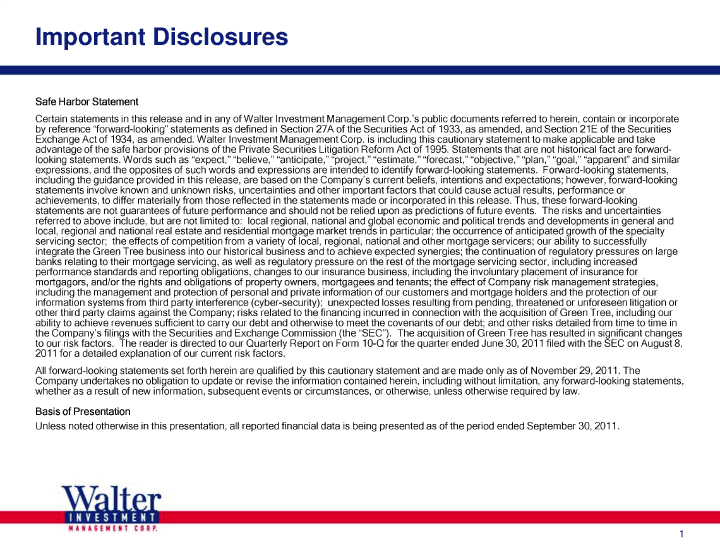
| Important Disclosures Safe Harbor Statement Certain statements in this release and in any of Walter Investment Management Corp. s public documents referred to herein, contain or incorporate by reference forward-looking statements as defined in Section 27A of the Securities Act of 1933, as amended, and Section 21E of the Securities Exchange Act of 1934, as amended. Walter Investment Management Corp. is including this cautionary statement to make applicable and take advantage of the safe harbor provisions of the Private Securities Litigation Reform Act of 1995. Statements that are not historical fact are forward-looking statements. Words such as expect, believe, anticipate, project, estimate, forecast, objective, plan, goal, apparent and similar expressions, and the opposites of such words and expressions are intended to identify forward-looking statements. Forward-looking statements, including the guidance provided in this release, are based on the Company s current beliefs, intentions and expectations; however, forward-looking statements involve known and unknown risks, uncertainties and other important factors that could cause actual results, performance or achievements, to differ materially from those reflected in the statements made or incorporated in this release. Thus, these forward-looking statements are not guarantees of future performance and should not be relied upon as predictions of future events. The risks and uncertainties referred to above include, but are not limited to: local regional, national and global economic and political trends and developments in general and local, regional and national real estate and residential mortgage market trends in particular; the occurrence of anticipated growth of the specialty servicing sector; the effects of competition from a variety of local, regional, national and other mortgage servicers; our ability to successfully integrate the Green Tree business into our historical business and to achieve expected synergies; the continuation of regulatory pressures on large banks relating to their mortgage servicing, as well as regulatory pressure on the rest of the mortgage servicing sector, including increased performance standards and reporting obligations, changes to our insurance business, including the involuntary placement of insurance for mortgagors, and/or the rights and obligations of property owners, mortgagees and tenants; the effect of Company risk management strategies, including the management and protection of personal and private information of our customers and mortgage holders and the protection of our information systems from third party interference (cyber-security); unexpected losses resulting from pending, threatened or unforeseen litigation or other third party claims against the Company; risks related to the financing incurred in connection with the acquisition of Green Tree, including our ability to achieve revenues sufficient to carry our debt and otherwise to meet the covenants of our debt; and other risks detailed from time to time in the Company s filings with the Securities and Exchange Commission (the SEC ). The acquisition of Green Tree has resulted in significant changes to our risk factors. The reader is directed to our Quarterly Report on Form 10-Q for the quarter ended June 30, 2011 filed with the SEC on August 8, 2011 for a detailed explanation of our current risk factors. All forward-looking statements set forth herein are qualified by this cautionary statement and are made only as of November 29, 2011. The Company undertakes no obligation to update or revise the information contained herein, including without limitation, any forward-looking statements, whether as a result of new information, subsequent events or circumstances, or otherwise, unless otherwise required by law. Basis of Presentation Unless noted otherwise in this presentation, all reported financial data is being presented a s of the period ended September 30, 2011. |
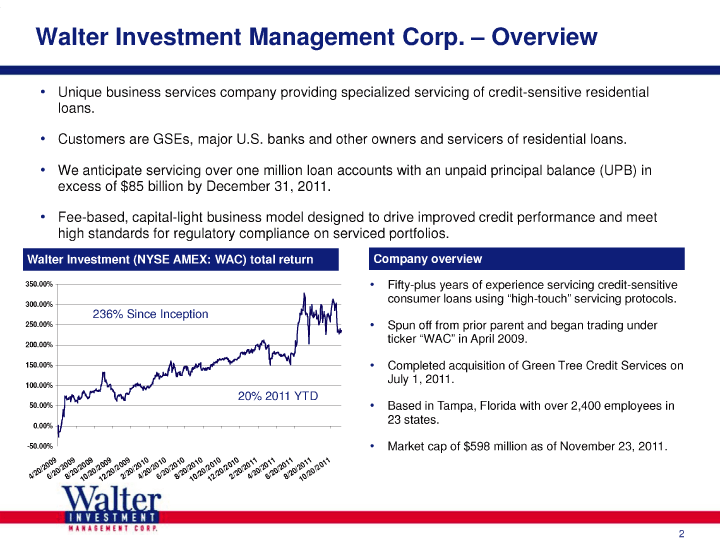
| Walter Investment Management Corp. Overview |
| Unique business services company providing specialized servicing of credit-sensitive residential loans. Customers are GSEs, major U.S. banks and other owners and servicers of residential loans. We anticipate servicing over one million loan accounts with an unpaid principal balance (UPB) in excess of $85 billion by December 31, 2011. Fee-based, capital-light business model designed to drive improved credit performance and meet high standards for regulatory compliance on serviced portfolios. |
| Company overview |
| Fifty-plus years of experience servicing credit-sensitive consumer loans using high-touch servicing protocols. Spun off from prior parent and began trading under ticker WAC in April 2009. Completed acquisition of Green Tree Credit Services on July 1, 2011. Based in Tampa, Florida with over 2,400 employees in 23 states. Market cap of $598 million as of November 23, 2011. |
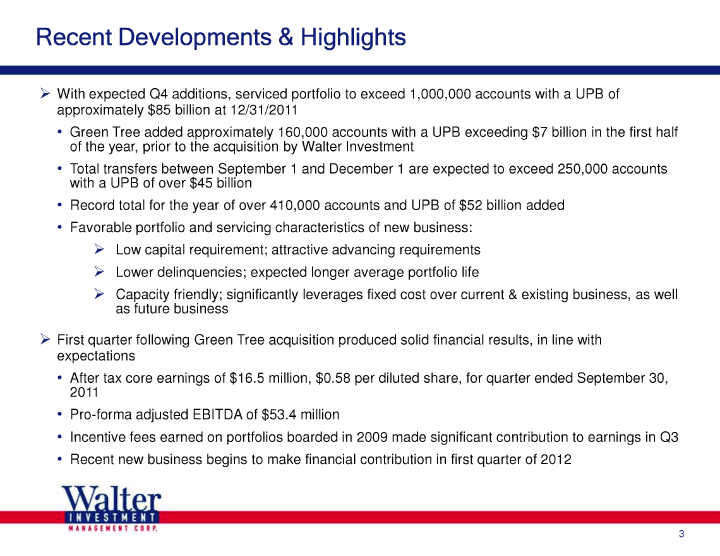
| Recent Developments & Highlights |
| 3 With expected Q4 additions, serviced portfolio to exceed 1,000,000 accounts with a UPB of approximately $85 billion at 12/31/2011 |
| Green Tree added approximately 160,000 accounts with a UPB exceeding $7 billion in the first half of the year, prior to the acquisition by Walter Investment Total transfers between September 1 and December 1 are expected to exceed 250,000 accounts with a UPB of over $45 billion Record total for the year of over 410,000 accounts and UPB of $52 billion added Favorable portfolio and servicing characteristics of new business: |
| 3 Low capital requirement; attractive advancing requirements 3 Lower delinquencies; expected longer average portfolio life |
| 3 Capacity friendly; significantly leverages fixed cost over current & existing business, as well as future business |
| 3 First quarter following Green Tree acquisition produced solid financial results, in line with expectations |
| After tax core earnings of $16.5 million, $0.58 per diluted share, for quarter ended September 30, 2011 Pro-forma adjusted EBITDA of $53.4 million Incentive fees earned on portfolios boarded in 2009 made significant contribution to earnings in Q3 Recent new business begins to make financial contribution in first quarter of 2012 |
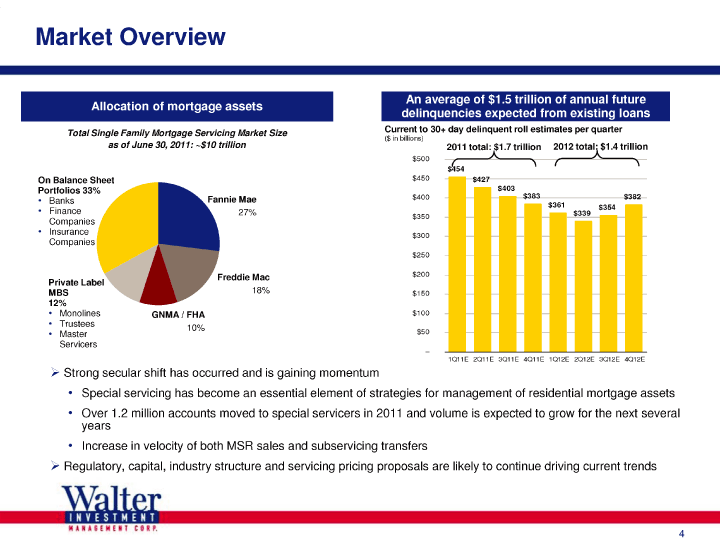
| Market Overview |
| An average of $1.5 trillion of annual future Allocation of mortgage assets delinquencies expected from existing loans |
| Current to 30+ day delinquent roll estimates per quarter |
| Total Single Family Mortgage Servicing Market Size |
| ($ in billions) |
| as of June 30, 2011: ~$10 trillion 2011 total: $1.7 trillion 2012 total: $1.4 trillion |
| 3 Strong secular shift has occurred and is gaining momentum |
| Special servicing has become an essential element of strategies for management of residential mortgage assets Over 1.2 million accounts moved to special servicers in 2011 and volume is expected to grow for the next several years Increase in velocity of both MSR sales and subservicing transfers |
| 3 Regulatory, capital, industry structure and servicing pricing proposals are likely to continue driving current trends |
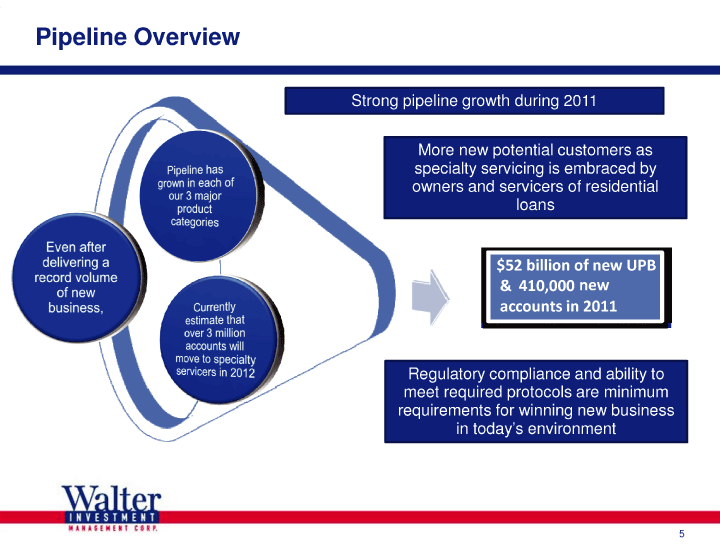
| Pipeline Overview |
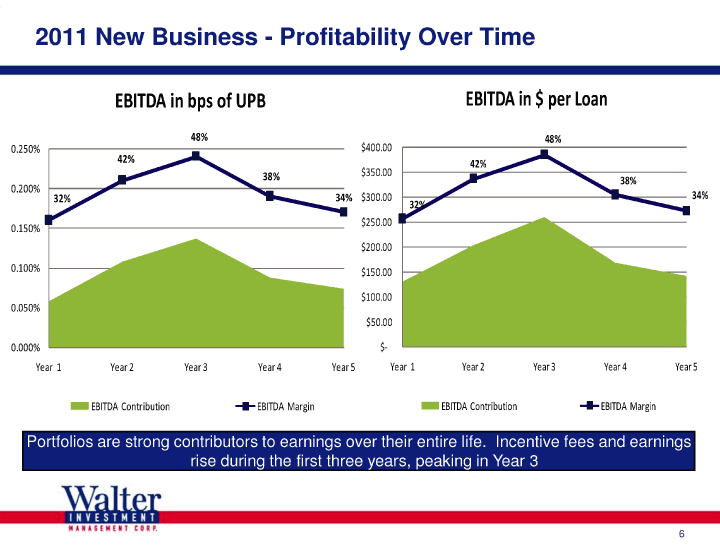
| 2011 New Business — Profitability Over Time |
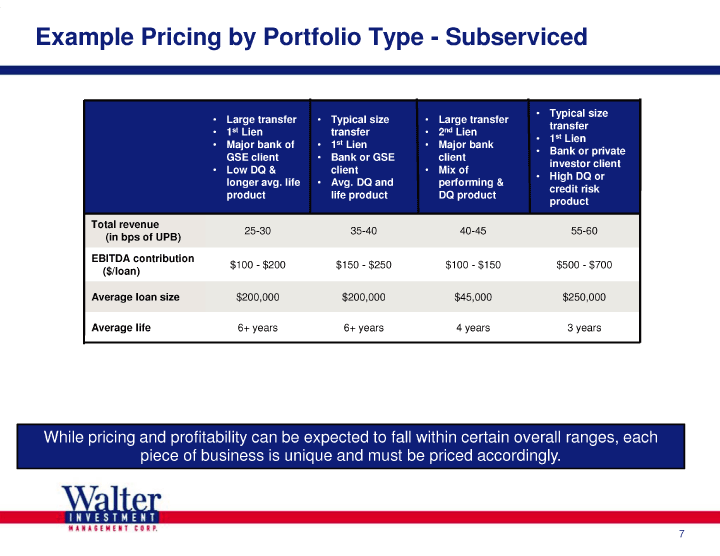
| Example Pricing by Portfolio Type — Subserviced |
| Typical size |
| Large transfer Typical size Large transfer transfer |
| 1st Lien transfer 2nd Lien |
| 1st Lien |
| Major bank of 1st Lien Major bank |
| Bank or private GSE client Bank or GSE client investor client |
| Low DQ & client Mix of |
| High DQ or longer avg. life Avg. DQ and performing & credit risk product life product DQ product product |
| Total revenue |
| 25-30 35-40 40-45 55-60 |
| (in bps of UPB) |
| EBITDA contribution $100 — $200 $150 — $250 $100 — $150 $500 — $700 |
| ($ /loan) |
| Average loan size $200,000 $200,000 $45,000 $250,000 Average life 6+ years 6+ years 4 years 3 years |
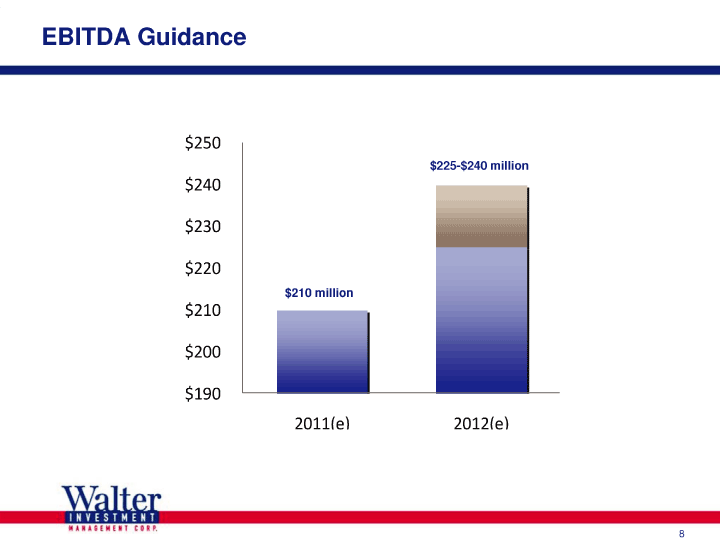
| EBITDA Guidance |
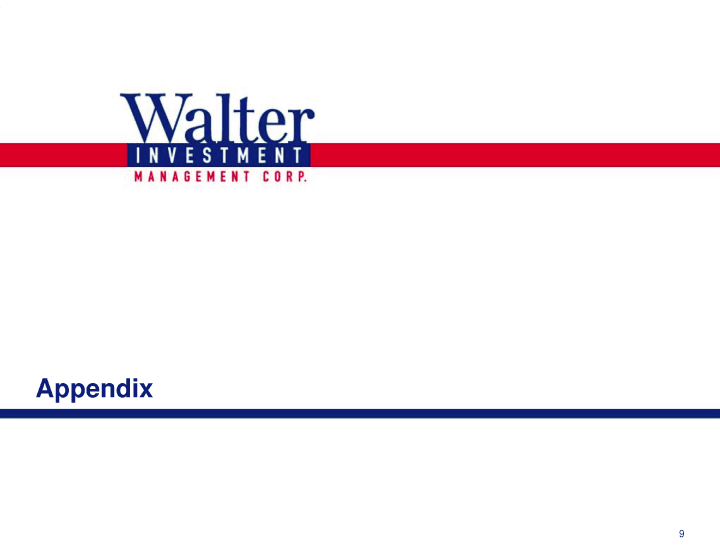
| Appendix |
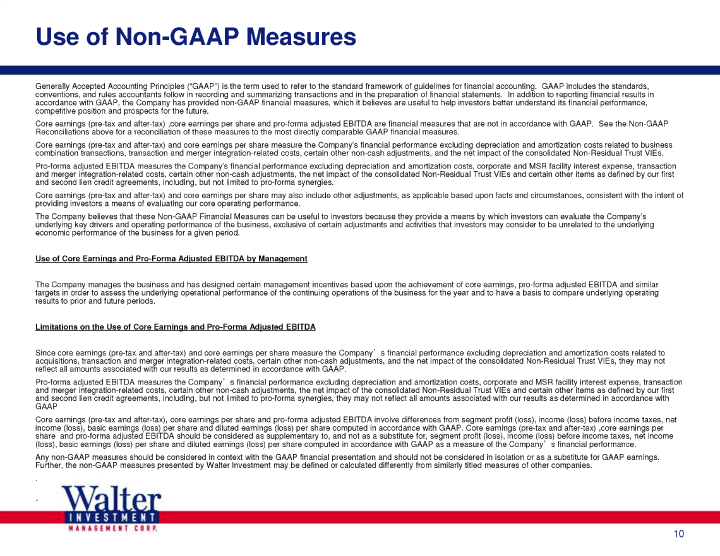
| Use of Non-GAAP Measures Generally Accepted Accounting Principles ( GAAP ) is the term used to refer to the standard framework of guidelines for financial accounting. GAAP includes the standards, conventions, and rules accountants follow in recording and summarizing transactions and in the preparation of financial statements. In addition to reporting financial results in accordance with GAAP, the Company has provided non-GAAP financial measures, which it believes are useful to help investors better understand its financial performance, competitive position and prospects for the future. Core earnings (pre-tax and after-tax) ,core earnings per share and pro-forma adjusted EBITDA are financial measures that are not in accordance with GAAP. See the Non-GAAP Reconciliations above for a reconciliation of these measures to the most directly comparable GAAP financial measures. Core earnings (pre-tax and after-tax) and core earnings per share measure the Company s financial performance excluding depreciation and amortization costs related to business combination transactions, transaction and merger integration-related costs, certain other non-cash adjustments, and the net impact of the consolidated Non-Residual Trust VIEs. Pro-forma adjusted EBITDA measures the Company s financial performance excluding depreciation and amortization costs, corporate and MSR facility interest expense, transaction and merger integration-related costs, certain other non-cash adjustments, the net impact of the consolidated Non-Residual Trust VIEs and certain other items as defined by our first and second lien credit agreements, including, but not limited to pro-forma synergies. Core earnings (pre-tax and after-tax) and core earnings per share may also include other adjustments, as applicable based upon facts and circumstances, consistent with the intent of providing investors a means of evaluating our core operating performance. The Company believes that these Non-GAAP Financial Measures can be useful to investors because they provide a means by which investors can evaluate the Company s underlying key drivers and operating performance of the business, exclusive of certain adjustments and activities that investors may consider to be unrelated to the underlying economic performance of the business for a given period. Use of Core Earnings and Pro-Forma Adjusted EBITDA by Management The Company manages the business and has designed certain management incentives based upon the achievement of core earnings, pro-forma adjusted EBITDA and similar targets in order to assess the underlying operational performance of the continuing operations of the business for the year and to have a basis to compare underlying operating results to prior and future periods. Limitations on the Use of Core Earnings and Pro-Forma Adjusted EBITDA Since core earnings (pre-tax and after-tax) and core earnings per share measure the Company s financial performance excluding depreciation and amortization costs related to acquisitions, transaction and merger integration-related costs, certain other non-cash adjustments, and the net impact of the consolidated Non-Residual Trust VIEs, they may not reflect all amounts associated with our results as determined in accordance with GAAP. Pro-forma adjusted EBITDA measures the Company s financial performance excluding depreciation and amortization costs, corporate and MSR facility interest expense, transaction and merger integration-related costs, certain other non-cash adjustments, the net impact of the consolidated Non-Residual Trust VIEs and certain other items as defined by our first and second lien credit agreements, including, but not limited to pro-forma synergies, they may not reflect all amounts associated with our results as determined in accordance with GAAP Core earnings (pre-tax and after-tax), core earnings per share and pro-forma adjusted EBITDA involve differences from segment profit (loss), income (loss) befor e income taxes, net income (loss), basic earnings (loss) per share and diluted earnings (loss) per share computed in accordance with GAAP. Core earnings (pre-tax and after-tax) ,core earnings per share and pro-forma adjusted EBITDA should be considered as supplementary to, and not as a substitute for, segment profit (loss), income (loss) before income taxes, net income (loss), basic earnings (loss) per share and diluted earnings (loss) per share computed in accordance with GAAP as a measure of the Company s financial performance. Any non-GAAP measures should be considered in context with the GAAP financial presentation and should not be considered in isolation or as a substitute for GAAP earnings. Further, the non-GAAP measures presented by Walter Investment may be defined or calculated differently from similarly titled measures of other companies. |
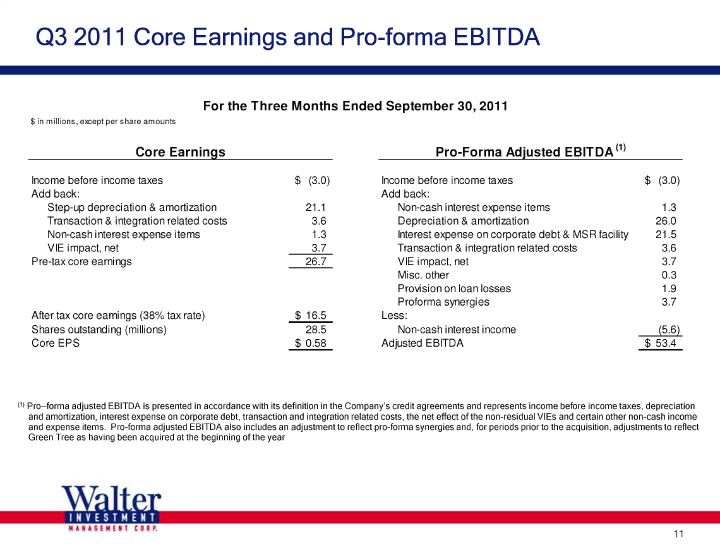
| Q3 2011 Core Earnings and Pro— -forma EBITDA |
| For the Three Months Ended September 30, 2011 $ in millions, except per share amounts |
| Core Earnings |
| Income before income taxes $ (3.0) Add back: Step-up depreciation & amortization 21.1 Transaction & integration related costs 3.6 Non-cash interest expense items 1.3 VIE impact, net 3.7 Pre-tax core earnings 26.7 |
| After tax core earnings (38% tax rate) $ 16.5 Shares outstanding (millions) 28.5 Core EPS $ 0.58 Pro-Forma Adjusted EBITDA (1) Income before income taxes $ (3.0) Add back: Non-cash interest expense items 1.3 Depreciation & amortization 26.0 Interest expense on corporate debt & MSR facility 21.5 Transaction & integration related costs 3.6 VIE impact, net 3.7 Misc. other 0.3 Provision on loan losses 1.9 Proforma synergies 3.7 Less: Non-cash interest income (5.6) Adjusted EBITDA $ 53.4 |
| (1) Pro—forma adjusted EBITDA is presented in accordance with its definition in the Company s credit agreements and represents income before income taxes, depreciation and amortization, interest expense on corporate debt, transaction and integration related costs, the net effect of the non-residual VIEs and certain other non-cash income and expense items. Pro-forma adjusted EBITDA also includes an adjustment to reflect pro-forma synergies and, for periods prior to the acquisition, adjustments to reflect Green Tree as having been acquired at the beginning of the year |
